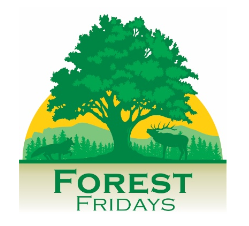Buffalo-Nut: A Hemi-Parasitic Shrub
By Rebecca Bowen
What lives in the Appalachians, grows about 16 feet tall, is oily, smelly, and takes its neighbors’ food? (No, not Bigfoot!)
Answer: The native hemi-parasitic shrub, buffalo-nut (Pyrularia pubera).
Buffalo-nut parasitizes the roots of many other plant species. It makes most of its own food but relies on other plants for water and nutrients, making it a hemi-parasite. A hemi-parasite is a green, flowering plant that derives some nutrition from another plant. Rootlets of buffalo-nut pierce the host plants’ roots through connections called haustoria.
It is a native to the Appalachian Mountains and foothills, found in mixed hardwood forests or mixed hardwood/conifer forests. Southwest Pennsylvania is the northern edge of its range. It has alternate, simple leaves and is a fairly non-descript shrub, except for its small, pear-shaped fruit and acrid smell.
Buffalo-nut leaves and fruit (Photos: Chris Evans, University of Illinois, Bugwood.org, CC by-NC 3.0)
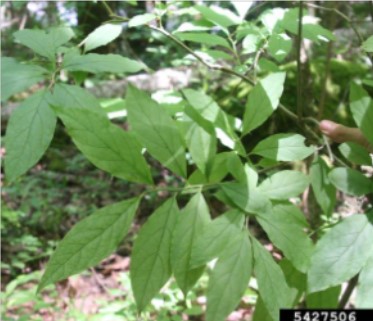
All parts of the plant produce a pungent oil, but it’s concentrated in the fruit and pit. Despite the smell, early settlers expressed the oil from the nut and used it for lamp oil and to treat rheumatism. Cherokees used the oil as a salve for “old sores” and chewed the nut to cure colic. Naturalists in the 19th century considered cultivating it for oil. Oil-nut is another common name for this reason.
Early settlers observed woodland buffalo and eastern elk eating the fruits, hence other common names: buffalo-nut and elk-nut.
Buffalo-nut fruit (Photo: Chris Evans, University of Illinois, Bugwood.org, CC by-NC 3.0)
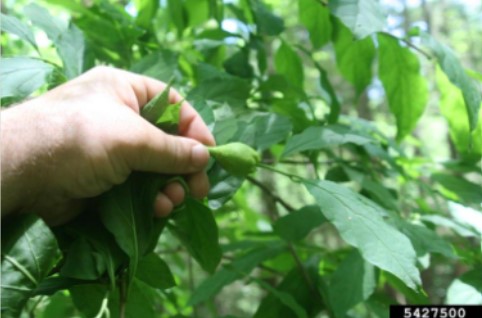
The plant is also high in nitrogen, phosphorus, potassium, calcium, and manganese (absorbed from hosts) making it very nutritious. Heavy deer browse of stems and foliage and consumption of fruit seriously limit buffalo-nut growth. Buffalo-nut also contains toxins such as calcium oxalate crystals and thionin, but deer, squirrels, horses, cattle, mice, and sheep can tolerate the toxins. It causes serious reactions in rabbits, pigs, and humans in large enough doses. The toxin is thought to act on the same receptors as cobra venom. It is not known how deer can browse this plant so heavily and not be affected by the toxin. The leaves appear early in the spring and stay on the tree late into the fall.
Buffalo-nut flowers (Photo: gaforestwatch, iNaturalist, CC by-NC 4.0)
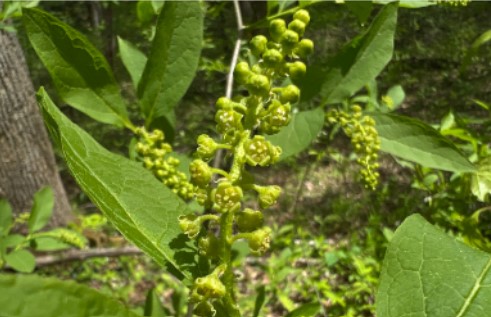
Buffalo-nut flowers are tiny and green, male on one plant and female on another, but sexual reproduction is low due to low plant abundance. It reproduces mainly by cloning and many populations are small and consist of the same sex. Adequate genetic flow among populations is a concern.
The lack of genetic variation was confirmed by genetics research by Carnegie Museum of Natural History and Powdermill Nature Reserve, funded by DCNR’s Wild Resource Conservation Program. They found that a few female individuals in an all-female population set seed when a male plant was introduced, but not vice-versa. Also, buffalo-nut may be able to switch sexes as a strategy to allow younger plants to invest less in reproduction as researchers observed a male plant develop into a female a few years later. Buffalo-nut also suffers from a bark blight caused by the fungus, Fusarium solani. The blight causes stems to die back but it will readily resprout in a year or two.
Two large, old, living buffalo-nut stems from a single root stock at Powdermill Nature Reserve, showing canker blisters. (Photo: John Wenzel, WRCP 18587 final report, Pyrularia pubera Resource Recovery Plan).
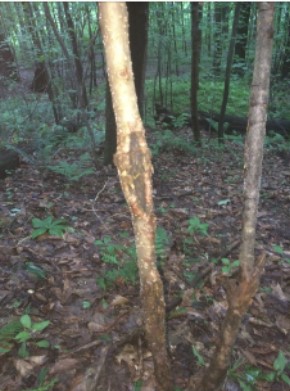
Buffalo-nut stem (Photo: Chris Evans, University of Illinois, Bugwood.org, CC by-NC 3.0)
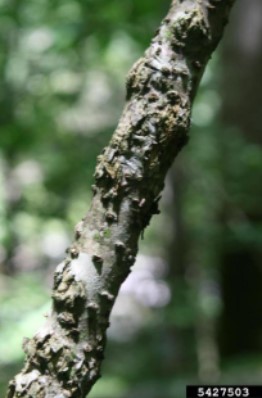
While buffalo-nut has a truly unique life history, it is not the only hemi-parasite found in Penn’s Woods. All plants in buffalo-nut’s family, the Sandalwood family (Santalaceae), are hemi-parasitic including bastard toadflax and dwarf mistletoe. The broom-rape family (Orobanchaceae) can also be hemi- parasitic, including the familiar cow-wheat and wood-betony.
Photos below:
(L) Cow-wheat (Photo: Jim Brighton, iNaturalist, CC-BY-NC 4.0.)
(R) Wood-betony (Photo: Eric Hunt, Wikimedia Commons, CC-BY-NC 4.0)
If you are out in the Appalachians in a southwestern Pennsylvania forest, be on the lookout for buffalo-nut or other hemi-parasites!
About the Author:
Rebecca Bowen is the Conservation Science and Ecological Resources Division Chief in the Pennsylvania Department of Conservation and Natural Resources’ Bureau of Forestry. She received her Bachelors of Science from Frostburg University in Maryland where she studied biology and writing, and her Masters of Science for ecology at Shippensburg University. She is keenly interested in native plant conservation, the natural history of the eastern US and tying that together with art and writing. Rebecca resides in Carlisle with her husband, dog and cat.
